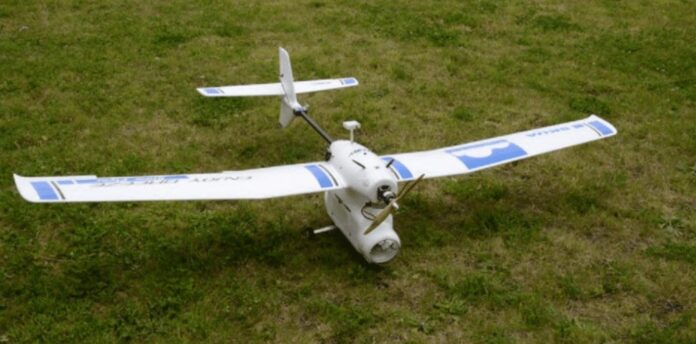Prior to delving into frame specifics, it’s critical to comprehend the attractiveness of Hobby Fixed Wing Drone Frame. Fixed-wing drones are made for continuous forward motion, which makes them perfect for long-distance flights in contrast to their multi-rotor cousins, which can hover in one spot. When efficiency and flight duration are important, they are usually utilized for pleasure flying, agricultural monitoring, surveying, and aerial mapping.
Table of Contents
Advantages of Fixed-Wing Drones:
- Extended Flight Durations: When compared to multi-rotor drones, fixed-wing drones have a far longer flight duration due to their aerodynamic design, which uses less power.
- Greater Speeds: Because fixed-wing drones are capable of substantially higher speeds, they can cover larger regions faster.
- Increased Range: They are the best option for operations requiring long-range capabilities due to their efficiency.
- Stability in Wind: Fixed-wing drones are more suited to withstand wind and turbulence conditions because of their construction, which makes for smoother flights over greater distances.
The Importance of a Hobby Fixed Wing Drone Frame
Any Hobby Fixed Wing Drone Frame, which offers stability and structure, is its skeleton. The frame of a fixed-wing drone is essential for maintaining structural integrity as well as controlling aerodynamics, weight distribution, and overall flying performance. Selecting the appropriate frame can make the difference between a successful flight and a catastrophe.
Key Considerations for Hobby Fixed Wing Drone Frame
A Hobby Fixed Wing Drone Frame needs take into account a number of factors, including:
- Material: The drone’s weight and durability are influenced by the material selection. Stronger materials, like aluminum or composite materials, give more durability in the event of a crash, while lighter materials, like carbon fiber or foam, extend flight periods.
- Size & Wingspan: The drone’s payload capacity, which includes additional batteries, cameras, and sensors, is determined by the size of its frame. More lift from a bigger wingspan can increase efficiency and allow for longer flight durations.
- Weight Distribution: To ensure stability and balance during flight, the drone’s frame should be built to spread the weight of its parts uniformly. Reduced flight efficiency and problems with control might result from improper weight distribution.
- Aerodynamics: The design of the frame must minimize drag and produce lift since fixed-wing drones depend on aerodynamics for flight. To maximize speed and flight endurance, designs must be sleek and streamlined.
- Modularity: Certain frames are modular, which makes it simple for enthusiasts to update or change out components. For individuals who prefer to experiment or gradually enhance their drone, this is a crucial factor to take into account.
- Durability: The drone can endure knocks and hard landings thanks to its sturdy frame. Picking a frame that can withstand a few knocks is essential, depending on how and where you intend to fly the drone.
Materials for Hobby Fixed Wing Drone Frame
Carbon Fiber
Professionals and serious drone hobbyists sometimes use carbon fiber. It is perfect for drones that need to reach high speeds and extended flight durations because it is lightweight yet incredibly sturdy. Although carbon fiber frames are lightweight and extremely durable, their cost can be higher than that of other materials.
Foam
For enthusiasts who want to make lightweight, inexpensive drones or who prefer a do-it-yourself project, foam is the material of choice. Particularly when composed of expanded polystyrene (EPS) or expanded polypropylene (EPP), foam frames are incredibly lightweight and flexible. They might not be as resilient to damage from hard landings, though, as carbon fiber or composite materials are.
Balsa Wood
For many years, balsa wood has been a common material for fixed-wing hobby fixed wing drone frame and is still used in traditional model aircraft. Similar to foam, it is inexpensive, lightweight, and simple to work with, although it may need to be reinforced because of its decreased durability.
Aluminum
Aluminum is a good option if strength is more important to you than weight reduction. Aluminum frames are more durable than frames made of lighter materials, but they are still able to endure impacts and crashes. To produce a balanced design, this material is frequently used with other lightweight materials.
Composite Materials
Composite materials, like Kevlar or fiberglass, combine the greatest qualities of metal with foam or wood, although they are lighter than metal. High-end hobby fixed wing drone frame made for competition or professional use frequently contain these materials.
Types of Fixed-Wing Drone Frames
Depending on the drone’s intended purpose, hobby fixed wing drone frame are available in a variety of designs. These are a few typical kinds:
Standard Fixed-Wing Frame
The most conventional frame design has a long fuselage to which two wings are attached. These frames are a fantastic option for novices since they are simple to assemble and use. They are appropriate for both aerial photography and general-purpose flying because they provide good stability.
2. Flying Wing Frame
With a flying wing frame, the fuselage is removed and all parts are housed inside the wings. Because of its great aerodynamics, this design increases efficiency and speed while lowering drag. Although flying wings are frequently employed in high-speed or long-distance applications, they might be more difficult for inexperienced pilots to handle.
Canard Frame
Smaller control surfaces are located in front of the primary wings, which are positioned toward the back of the frame in a canard shape. Although this design improves stability and maneuverability, designing and flying it well demands a deeper understanding of aerodynamics.
VTOL (Vertical Take-Off and Landing) Hybrid Frame
Certain fixed-wing drones can take off and land vertically, much like multirotor drones, thanks to their VTOL capabilities. Applications that need to be able to function in cramped areas and have long-range efficiency are starting to use these hybrid frames more frequently.
Building vs. Buying a Fixed-Wing Drone Frame
Building Your Own Frame
Starting from scratch or utilizing a kit, making a hobby fixed wing drone frame can be a satisfying project for enthusiasts who like modification and tinkering. This gives total control over the layout, selection of materials, and positioning of components. You can also customize the drone to fulfill particular requirements by building your own frame, such as increasing speed, carrying payloads, or extending flight durations.
Buying a Pre-Made Frame
However, if you want to get airborne immediately without having to deal with the hassles of constructing, buying a pre-made frame or a ready-to-fly (RTF) kit is a great alternative. Because of their performance and simplicity of installation, these frames are perfect for novices or enthusiasts who would rather fly than build.
Conclusion
The performance of your hobby fixed-wing drone is built on its frame, thus choosing the proper one is essential to its success. Making an informed choice will be aided by your knowledge of the various materials, designs, and features, whether you’re building your drone from the ground up or buying a pre-made frame. As you delve deeper into the realm of fixed-wing drones, keep in mind that the correct frame can improve your flying experience by offering the durability, stability, and efficiency required for extended, pleasurable flights.



